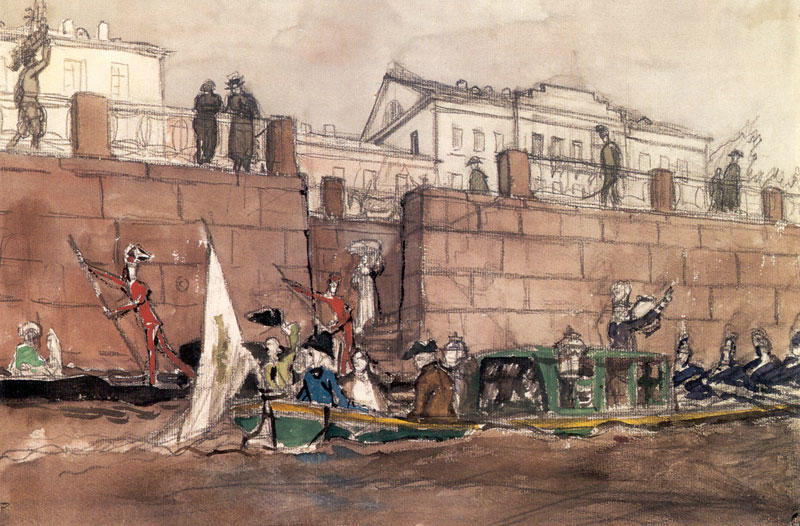It has been almost a month since our first “crossmedial exhibitions” class meeting. Back then, while looking through tons of massive books,I got an impression that throughout the whole period we all would tackle difficult reading material in order to understand intricate aspects of museum studies. However, after our first (and so far last) texts discussion, this course turned into an absolutely different experience. Even though text readings and following discussions are the most common (and, of course, useful) practices in the education process, it has been a pleasure to try some other ways of learning.
First and foremost, it becomes apparent that there is no better way to learn about the museums than going to the museums. The position of an actual viewer allows to learn not only about the objects and the stories behind them, but also reveals how the museum arranges a dialog between the objects, spaces, and the visitors. This dialog reminds me of an aesthetic ritual that at its best enables visitors to experience intellectual or emotional (sometimes even both) growth. And at its worst, does not evoke any reactions. Keeping in mind this ritualistic nature of relationships between the museum and the visitors, I always try to be self-reflexive while wandering through the museum galleries. As the only thing one can take outside the museum (legally) is his/her personal impressions, I believe that self-reflexiveness is a good tool to analyze conceptual/curatorial/design strategies used by the museum to make an impact on their visitors.
In this regard, our discussion with Vincent Boele, curator of 1917 – Romanovs and Revolution exhibition at the Hermitage museum, was a great fortune, as finally I ( and probably all of the students) was left not only with my self-reflexiveness and guesses about the exhibition on point, but also had an opportunity to learn about a real process of making the exhibition, a process that is usually hidden behind the curtains. Vincent was kind enough to answer our questions and share about his experience of working at the museum.
From what we have heard from Vincent, the Hermitage museum in Amsterdam is in a partnership relations with the State Hermitage Museum in Saint-Petersburg. However, I am surprised at how local Hermitage is dependent on St. Petersburg’s State Hermitage Museum. At some point, it might seem that Amsterdam’s Hermitage is very limited in terms of its own freedom, especially when it comes to the access to the collections stored in Russia. Vincent was a little bit vague on connections with the museums other than those in St.Petersburg, so I was left with a feeling that the Hermitage functions as a branch rather than an independent institution.
Nevertheless, curatorial and organizational freedom of the museum was not doubted at any point.When our discussion made a turn from St.Petersburg – Amsterdam relations to the exhibition design, Vincent explained that “an exhibition is about the objects, it is not a book you read”. In a way, I think it makes sense to tell a story through the objects, because at the end of the day visitors do not leave the museum with the memories of what they’ve just read, but rather with the memories of what they have seen. Our long discussion on audience and target groups made it clear that the Hermitage team treats their visitors in a careful manner and tries to count all small nuances to facilitate the experience of the museum (from organizing tours for the youngest audience to using large text formats for the older groups).
When I walked through the “Passage” (“the conceptual floor” in Vincent’s words) I could not stop thinking of the atmosphere in Saint-Petersburg before revolution. Annelise mentioned that the second floor’s density reminded her of the masses and their struggles. But for me, space syntax on the first floor reminded of flâneur culture so popular at that times amongst Russian bourgeoise. Dames accompanied by their gentlemen imposingly strolled around the city streets glancing to shop windows and stopping by to have a small talk over a cup of coffee. Saint-Petersburg has never been more European than that. It was a pleasure to know that Vincent’s main intention was to show this part of Russian history, which is, unfortunately, has been forgotten so frequently. Small paintings and prints by Leon Bakst, Alexander Benoit, and Maximilian Voloshin perfectly completed a visual image of the city and its mood. However, Russian Avant-garde would have fit this visual narrative probably even better, as it was all about the freedom of thought (not in a communist, but in a “European” sense).Yet, again, Vincent explained how difficult it is to get the objects from Russian storages in St. Petersburg. The Hermitage obviously dances around these issues and makes it all work at a highly respectable level thanks to creative approach.
Last but not the least, (even though it was not a secret before) it becomes crystal clear only now that the museum is not only a palace of wisdom, ceremonial monument, and a temple of knowledge, it is also a complex system of numerous departments, invisible workers and hidden structures. I’m looking forward to exploring.
by Sveta Kirillova

Excellent post, and yes, we will continue to explore.
LikeLike
Do you see connections with the course literature?
LikeLike